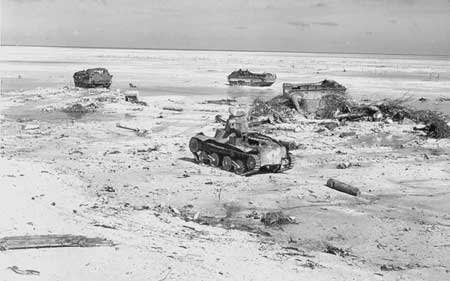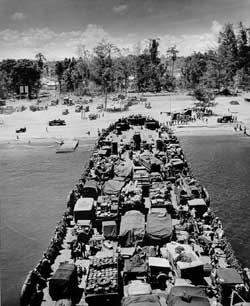| The War in the Pacific |
|
|
The Gilbert Islands As troops went ashore at Vella Lavella and Bouganville, the Allies staged their planned thrust into the Central Pacific. The Central Pacific Campaign began with the capture of the Gilbert Islands. The Gilbert Island chain is about 1,300 miles northeast of the Solomon Island chain. Here the Japanese augmented their forces, strengthened their positions and developed a centralized and efficient base force command, making the islands more difficult to conquer. The Allies planned the initial assault for the Tarawa and Makin atolls. About 200 vessels assembled to put ashore 27,600 assault troops, 7,600 garrison troops, 6,000 vehicles, and 117,000 tons of cargo. The large number of ships were organized into three main groups, the Assault Force, the Carrier Force, and the Defense Force. The Assault Force contained many Coast Guard ships, and was further divided into a Northern Attack Force to assault Makin and a Southern Attack Force to attack Tarawa. The Coast Guard-manned assault transport Leonard Wood (APA-12), a veteran of both the North African and Sicilian campaign, operated with the Northern Attack Force against Makin. The Arthur Middleton (APA-25) sailed with the Southern Attack group to Tarawa. Five Coast Guard-manned LSTs also participated in the landings. In the Gilberts the Allies, for the first time, would face a strongly defended beach. On the small atolls there was no undefended place to land due to the narrowness of the beaches. At the triangular-shaped Makin Atoll, the Japanese had fortified only one island, the largest island of Butaritari. The island hosted a seaplane base, but the defenses were incomplete and the garrison small. Only about 300 combat troops and 500 Korean construction workers defended the island. On Nov. 20, the invasion force arrived. The transports approached and hove to about 6,000 yards offshore. Since a surprise landing was not possible, the beaches were subjected to a heavy bombardment. Carrier planes and battleships blasted Japanese positions before the landing craft reached the two beaches selected for landings. The Leonard Wood operated off Red Beach and had aboard more than 1,700 officers and men. They began lowering fully-loaded boats at 6:03 a.m. The boats waited for some time while the bombardment proceeded. The bombardment stopped at 8:24 a.m. and the Leonard Wood's boats touched shore at 8:40 a.m. The landings here went according to plan and the assault troops moved rapidly inland. The coral reef surrounding the island complicated the landings. A miscalculation of the lagoon's depth required the landing forces to come ashore entirely in the diminutive LVTs. Eight waves of larger landing craft, unable to get over the coral, caused confusion, delay, and the abandonment of landing craft at the coral heads. Many of the troops had to wade the 250 yards to the beach in waist-deep water. Fortunately for the Americans the Japanese inflicted relatively few casualties on those wading ashore because they defended the interior of the island rather than the beachhead.
The Coast Guard boatcrews had grueling and often dangerous jobs. They unloaded their craft on the beaches while under fire from Japanese snipers. The coxswains and their crews worked at Makin for several days, never leaving their boats even to eat or sleep. Coffee and food were lowered to them on a line from the transports and they slept on their cargo while anchored in the lagoon - all the while being awakened by random fire from shore.
At Tarawa, 100 miles to the south of Makin, the Japanese had prepared strong defenses. The atoll is roughly triangular in shape and the coral heads extended between 500 and 1,000 yards off shore. Betio, the only defended island, lay on the southern side of the coral formation and comprised a mere 291 acres which allowed the Japanese to defended every inch. Only the Pacific island of Iwo Jima was more strongly defended. About 4,800 men, more than half combat troops, manned the fortifications. Just before 4 a.m. Nov. 20, the Southern Attack force reached its destination off Betio. The transports arrived in their areas and immediately began lowering their boats. The Arthur Middleton arrived at the transport area off Makin at 3:55 a.m. Coast Guardsmen also served aboard three other transports and manned five LSTs that carried garrison troops ashore. The ships in the shore bombardment group shelled the beaches for only a short time prior to the landing of the Marines. The Arthur Middleton carried the Second Marine Division Battalion Landing Team, an aggregate of over 1,400 officers and men. These men disembarked into LVTs that had been brought to the atoll by the large LSTs. The shallow-draft LVTs preceded the LCVPs and LCMs and made up the first three waves going to the beach. The assault called for a landing inside the lagoon on the north side of the island. The tide, wind and sea delayed the LVTs arrival to line of departure. Real trouble developed when the successive three waves of the deeper-drafted LCVPs and LCMs attempted to run to the beaches. These craft could not get over the shallow reefs and the troops had to be unloaded into rafts, onto a pier that ran out beyond the reef, or into the LVTs on their return trips. That afternoon about 200 craft bobbed outside the coral reef with troops or supplies waiting to land. Complicating matters further, the Marines had failed to establish a completely secure beachhead and only nominally controlled three by nightfall. By the morning of Nov. 21 the beach parties established better control. The fighting continued and proved to be some of the fiercest of the war. The Arthur Middleton put ashore a beach party of three officers and 43 men that stayed ashore for five days, supervising the landing of boats and unloading equipment. From Nov. 21 to 23, air and naval gunfire, and artillery brought ashore, assisted the Marines as they pushed the Japanese to the eastern end of the island. The Japanese did not surrender and had to be virtually annihilated. |

